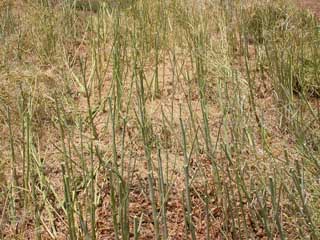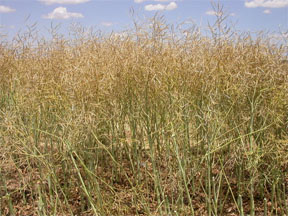Growth and Development
Field and Variety Selection
- Grows best in medium-textured well drained soils, but will grow in a wide range of soils.
- A soil pH between 6.0 and 7.0 is optimal. Yields maybe reduced by pH below 5.5.
- Canola does not tolerate water-logged conditions and should not be grown in fields with a history of poor drainage.
- Only tested winter hardy varieties should be planted.
- Other factors are oil quality, seed yield, lodging, shattering, maturity, and disease resistance.
- Private companies are testing varieties for their potential use in the Great Plains.
Canola Seedling Growth and Development
- Seedling emerges 4 to 10 days after planting and develops a short stem.
- Unlike wheat, whose growing point is protected beneath the soil during development, the growing point of canola is above the soil between the two cotyledons.
- The exposed growing point makes seedlings more susceptible than wheat to environmental hazards.
Cotyledon Canola
- Susceptable to foilage feeding insects.
- Furrows are a potential problem during heavy rain.
- Crusting can be a problem.
- Canola seedlings are not competitive with weeds.
- Seedlings are susceptible to freeze damage.
- Canola with 3 to 4 leaves is very tolerant to freezing weather.
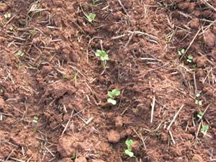
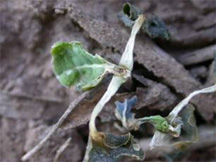
Canola Fall Rosette Growth and Development
- First true leaves develop 4 to 8 days after emergence.
- Secondary roots grow from the tap root. Stem length remains unchanged as thickness increases.
- Rapid establishment of leaf canopy is important in root and crown development.
- Winter survival is affected strongly by the amount of growth produced in the fall.
- Canola survival is increased when plants have seven or eight leaves and canopy is about 8 to 10".
- Canola roots will not grow into waterlogged, dry or compacted soil.
- Roots grow approx. four to five feet deep.
Winter Canola Plant and Root System

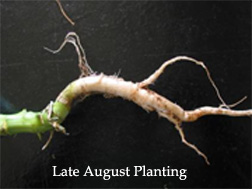
Winter Freeze Response
- Typical winter response during (rosette) semi dormant stage.
- Fall Foilage is produced for over wintering.
- Spring foliage (bolting) is produced mainly for seed production.
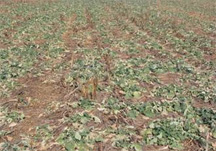

Winter Dormancy and Spring Regrowth
- Leaves often discolor, turn purple and die in the winter. Much of the leaf tissue freezes and dries, but as long as the crown does not die, the plants are alive.
- Growth resumes in early spring with new leaves appearing from the plant crown.
- A cluster of flower buds become visible at the center of the rosette and rises as the stem rapidly bolts.
- The main stem reaches 60% of its height just prior to flowering.
- New upper leaves are the major sites for pod set, early seed development and maximum yield.
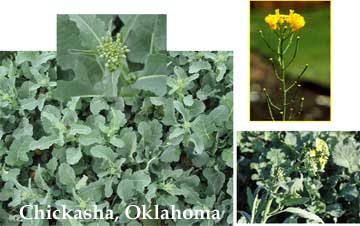
Canola Flowering
- Flowering begins with the opening of the lowest bud on the main stem and continues upward. Three to five flowers open each day. Flowering continues for 2 to 3 weeks.
- Canola plants initiate more flower buds that can develop into productive pods. Only half the flowers that open will develop into productive pods.
- When late spring frost cause abortion of flowers or pods, the plant can recover by development of flower buds that otherwise would have been aborted.
Canola Ripening
- At this stage, the stem and pod walls are the major sources of nutrients for seed growth.
- Leaves, stems and pod surfaces need to be kept free from disease, insect, or weather damage.
- The firm green seed has adequate oil and protein to support future germination.
- The stems and pods turn yellow and become brittle as they dry out.
- The seed coat turns from green to brown, and seed moisture is lost rapidly. When the seed is completely ripe, it is a dark uniform color.
Residue left on Soil Surface
